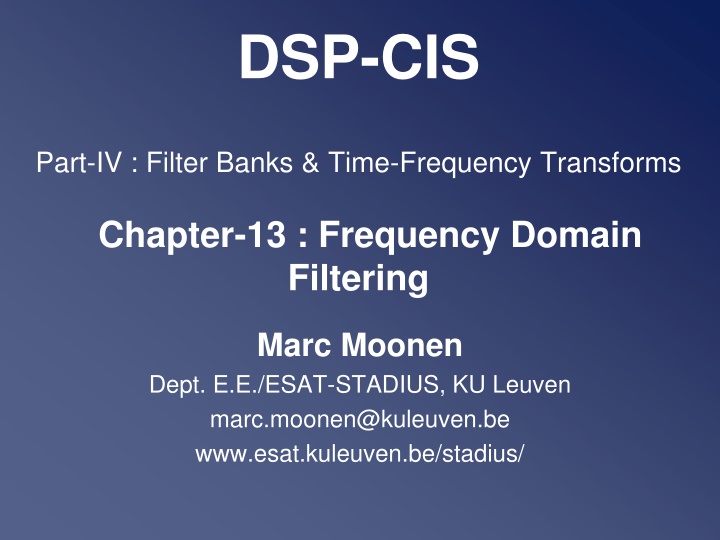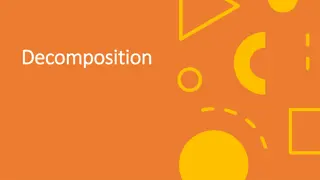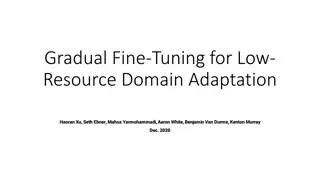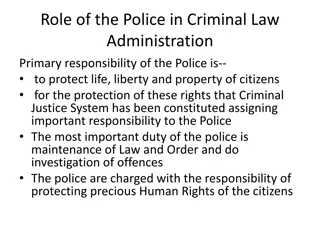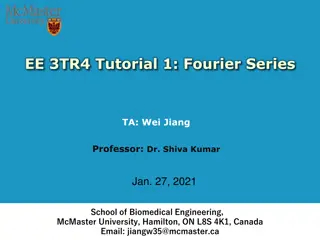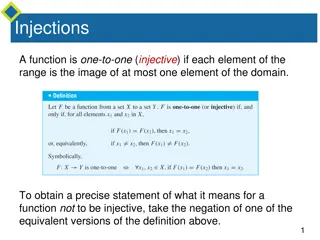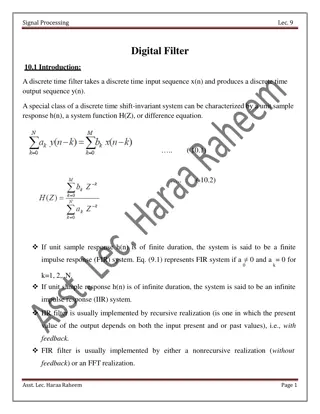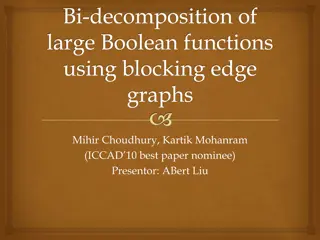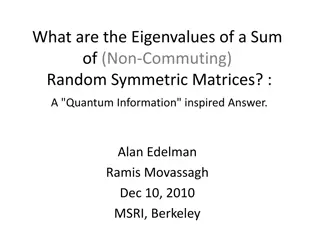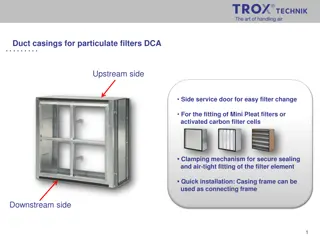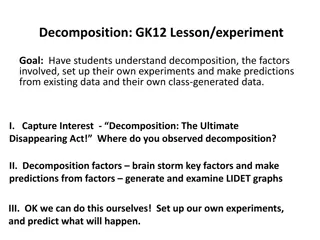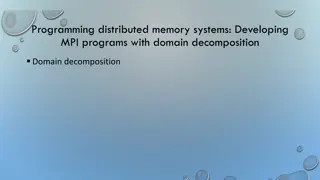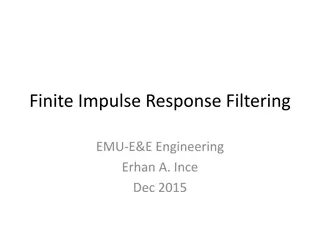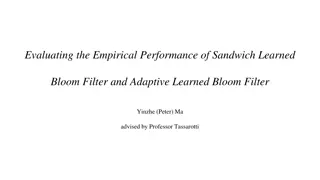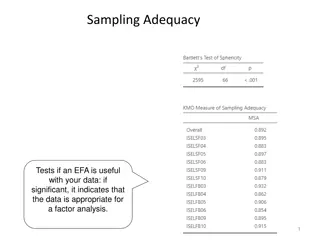Frequency Domain FIR Filter Realization and Eigenvalue Decomposition
FIR filter realization in the frequency domain involves constructing LTI systems using delay elements, adders, and multipliers. The eigenvalue decomposition of circulant matrices and the relationship with DFT matrices are key concepts discussed in the context of filter banks and time-frequency transforms.
Download Presentation

Please find below an Image/Link to download the presentation.
The content on the website is provided AS IS for your information and personal use only. It may not be sold, licensed, or shared on other websites without obtaining consent from the author.If you encounter any issues during the download, it is possible that the publisher has removed the file from their server.
You are allowed to download the files provided on this website for personal or commercial use, subject to the condition that they are used lawfully. All files are the property of their respective owners.
The content on the website is provided AS IS for your information and personal use only. It may not be sold, licensed, or shared on other websites without obtaining consent from the author.
E N D
Presentation Transcript
DSP-CIS Part-IV : Filter Banks & Time-Frequency Transforms Chapter-13 : Frequency Domain Filtering Marc Moonen Dept. E.E./ESAT-STADIUS, KU Leuven marc.moonen@kuleuven.be www.esat.kuleuven.be/stadius/
Part-IV : Filter Banks & Time-Frequency Transforms Chapter-11 Filter Bank Preliminaries Filter Bank Design Chapter-12 Frequency Domain Filtering Frequency Domain FIR Filter Realization Frequency Domain Adaptive Filtering Chapter-13 Time-Frequency Analysis & Scaling Chapter-14 DSP-CIS 2019-2020 / Chapter-13: Frequency Domain Filtering 2 / 26
FIR Filter Realization FIR Filter Realization =Construct (realize) LTI system (with delay elements, adders and multipliers), such that I/O behavior is given by.. y[k]=b0.u[k]+b1.u[k-1]+...+bL-1.u[k-L+1] Several possibilities exist 1. Direct form 2. Transposed direct form 3. Lattice realization (LPC lattice) 4. Lossless lattice realization 5. Frequency domain realization: see Part IV DSP-CIS 2019-2020 / Chapter-13: Frequency Domain Filtering 3 / 26
Frequency Domain FIR Filter Realization Have to know a theorem from linear algebra here: A `circulant matrix is a matrix where each row is obtained from the previous row using a right-shift (by 1 position), the rightmost element which spills over is circulated back to become the leftmost element The eigenvalue decomposition of a circulant matrix is always given as... (4x4 example) = a b c d a d c b b a d c c b a d d c b a 0 0 0 a d c b A 0 A a 0 0 b a d c B 0 B b = 1 . F . with , . F F 0 0 c b a d C 0 C c 0 0 D D d with F the DFT-matrix. This means that the eigenvectors are equal to the column-vectors of the IDFT-matrix, and that then eigenvalues are obtained as the DFT of the first column of the circulant matrix (proof by Matlab) DSP-CIS 2019-2020 / Chapter-13: Frequency Domain Filtering 4 / 26
Frequency Domain FIR Filter Realization FIR Filter Realization (example L=4, similar for other L) y[k]=b0.u[k]+b1.u[k-1]+b2.u[k-2]+b3.u[k-3] B(z)=b0+b1z-1+b2z-2+b3z-3 Consider a 'block processing where a block of LB output samples are computed at once, with block length LB=L: u[k] u[k-1] u[k -2] u[k -3] u[k -4] u[k -5] u[k -6] u[k -7] 0 b3 b2 b1 0 0 b3 b2 0 0 0 b3 0 0 0 0 b0 0 0 0 b1 b0 0 0 b2 b1 b0 0 b3 b2 b1 b0 y[k] y[k -1] y[k -2] y[k -3] = . DSP-CIS 2019-2020 / Chapter-13: Frequency Domain Filtering 5 / 26
Frequency Domain FIR Filter Realization Now some matrix manipulation DSP-CIS 2019-2020 / Chapter-13: Frequency Domain Filtering 6 / 26
Frequency Domain FIR Filter Realization This means that a block of LB=L output samples can be computed as follows (read previous formula from right to left) : Compute DFT of 2L input samples, i.e. last L samples combined ( overlapped ) with previous L samples B0 B1 B2 B3 B4 B5 B6 B7 0 b3 b2 b1 b0 0 0 0 Perform component-wise multiplication with (=freq.domain representation of the FIR filter) = F. Compute IDFT Throw away 1st half of result, select ( save ) 2nd half This is referred to as an overlap-save procedure (and frequency domain filter realization because of the DFT/IDFT) DSP-CIS 2019-2020 / Chapter-13: Frequency Domain Filtering 7 / 26
Frequency Domain FIR Filter Realization This corresponds to afilter bank-type realization as follows... 4 (z H ) (z E 4 4 4 4 1 3 z z z z 4 4 4 y[k] u[k] 2 R 1 z ) (z ) + 2 1 z 1 3 I Analysis bank: 4 4 x I = E ( ) . . z F 1 . z 4 4 x Subband processing: H(z)=diag{B0,B1,...B7} Synthesis bank: = 1 R ( ) 0 . z I F 4 4 x This is a 2L-channel filter bank, with L-fold downsampling The analysis FB is a 2L-channel uniform DFT filter bank (see Chapter 11) The synthesis FB is matched to the analysis bank, for PR: = 1 R E ( ). ( ) z z z I 4 4 x DSP-CIS 2019-2020 / Chapter-13: Frequency Domain Filtering 8 / 26
Frequency Domain FIR Filter Realization Overlap-save procedure is very efficient for large L : Computational complexity (with FFT/IFFT i.o. DFT/IDFT) is 2.[ .2L.log(2L)] + 2L multiplications for L output samples, i.e. O(log(L)) per sample for large L Compare to computational complexity for direct form realization: L multiplications per output sample, i.e. O(L) per sample Overlap-save procedure introduces O(L) processing delay/latency (e.g. y[k-L+1] only available sometime after time k) Conclusion: For large L, complexity reduction is large, but latency is also large Will derive intermediate realizations, with a smaller latency at the expense of a smaller complexity reduction. This will be based on an Nth order polyphase decomposition of B(z) DSP-CIS 2019-2020 / Chapter-13: Frequency Domain Filtering 9 / 26
Frequency Domain FIR Filter Realization A compact derivation will rely on a result from filter bank theory (return to Chapter-11 ) 4 4 4 4 4 3 z 1 T(z)*u[k-3] u[k] 4 4 4 2 T z (z ) 1 z z z + 1 z 1 2 3 ( and now let B(z) take the place of distortion function T(z)) This means that a filter (specified with N-fold polyphase decomposition) B(z)= p0(z4)+z-1p1(z4)+z-2p2(z4)+z-3p3(z4) can be realized in a multirate structure, based on a pseudo-circulant matrix = ) ( z T ( ) ( ) ( ) ( ) p z p z p z p z 0 1 2 3 1 . ( ) ( ) ( ) ( ) z p z p z p z p z 3 0 1 2 = 1 1 . ( ) . ( ) ( ) ( ) z p z z p z p z p z 2 3 0 1 1 1 1 . ( ) . ( ) . ( ) ( ) z p z z p z z p z p z 1 2 3 0 DSP-CIS 2019-2020 / Chapter-13: Frequency Domain Filtering PS: formulas given for N=4, for conciseness (but without loss of generality) 10 / 26
Frequency Domain FIR Filter Realization Now some matrix manipulation (compare to p.6) DSP-CIS 2019-2020 / Chapter-13: Frequency Domain Filtering 11 / 26
Frequency Domain FIR Filter Realization An (8-channel) filter bank representation of this is... 4 ) (z E 4 4 4 4 1 3 z z z z 4 4 4 y[k] u[k] 2 H R 1 z (z ) (z ) + 2 1 z 1 3 I 4 4 x I = Analysis bank: E ( ) . . z F 1 . z 4 4 x Subband processing: H(z)=diag{P0(z),P1(z),...P7(z)} Synthesis bank: = 1 R ( ) 0 . z I F 4 4 x This is a 2N-channel filter bank, with N-fold downsampling (see Chapter 13) The analysis FB is a 2N-channel DFT filter bank (see Chapter 11) The synthesis FB is matched to the analysis bank, for PR: = 1 R E ( ). ( ) z z z I 4 4 x DSP-CIS 2019-2020 / Chapter-13: Frequency Domain Filtering 12 / 26
Frequency Domain FIR Filter Realization This is again known as an `overlap-save realization : Analysis bank: performs 2N-point DFT (FFT) of a block of (N=4) samples, together with the previous block of (N) samples (hence `overlap ) . ) ( = F z E I `block `previous block 4 4 x I . 1 . z 4 4 x Synthesis bank: performs 2N-point IDFT (IFFT), throws away the 1st half of the result, saves the 2nd half (hence `save ) 0 ) ( = z R 1 . I F 4 4 x `throw away `save Subband processing corresponds to `frequency domain operation Complexity/latency? See p.16 DSP-CIS 2019-2020 / Chapter-13: Frequency Domain Filtering 13 / 26
Frequency Domain FIR Filter Realization Derivation on p.10 can also be modified as follows DSP-CIS 2019-2020 / Chapter-13: Frequency Domain Filtering 14 / 26
Frequency Domain FIR Filter Realization This is known as an `overlap-add realization : Analysis bank: performs 2N-point DFT (FFT) of a block of (N=4) samples, padded with N zero samples ) ( = F z E I `block `zero padding 4 4 x . . 0 4 4 x Synthesis bank: performs 2N-point IDFT (IFFT), adds 2nd half of the result to 1st half of previous IDFT (hence `add ) ) ( = z R . 1 1 . z I I F 4 4 4 4 x x `overlap `add Subband processing corresponds to `frequency domain operation DSP-CIS 2019-2020 / Chapter-13: Frequency Domain Filtering 15 / 26
Frequency Domain FIR Filter Realization Computational complexity is (with FFT/IFFT i.o. DFT/IDFT, plus subband processing) 2.[ .2N.log(2N)] + 2L multiplications for N output samples, i.e. O(log(N))+O(L/N) per sample For large N L this is O(log(L)) i.e. dominated by FFT/IFFT (cheap!) For N<<L this is O(L), i.e. dominated by subband processing Processing delay/latency is O(N) Standard `overlap-add and `overlap-save (=p.7) realizations are derived when 0th order poly-phase components are used in the above derivation (N=L, i.e. each poly-phase component has only 1 filter coefficient). For large L, this leads to a large complexity reduction, but also a large latency (=O(L)) In the more general case, with higher-order polyphase components (N<L, i.e. each poly-phase component has >1 filter coefficients) a smaller complexity reduction is achieved, but the latency is also smaller (=O(N)). DSP-CIS 2019-2020 / Chapter-13: Frequency Domain Filtering 16 / 26
Frequency Domain Adaptive Filtering A similar derivation can be made for LMS-based adaptive filtering with block processing ('Block-LMS'). The adaptive filter then consist in a filtering operation plus an adaptation operation, which corresponds to a correlation operation. Both operations can be performed cheaply in the frequency domain.. Starting point is the LMS update equation wk+1=wk+m.xk.(d[k]-xk Twk) DSP-CIS 2019-2020 / Chapter-13: Frequency Domain Filtering 17 / 26
Frequency Domain Adaptive Filtering Consider block processing with so-called 'Block-LMS' Remember that LMS is a stochastic gradient algorithm, where instantaneous estimates of the autocorrelation matrix and cross- correlation vector are used to compute a gradient (=steepest descent vector) Block-LMS uses averaged estimates, with averaging over a block of LB(= block length ) samples, and hence an averaged gradient. nLB+LB The update formula is then.. where n is the block index wn+1=wn+m. xk.(d[k]-xk Twn) k = nLB+1 Compared to LMS, Block-LMS does fewer updates (one per LB samples), but with (presumably) better gradient estimates. Overall, convergence could be faster or slower (=unpredictable). The important thing is that Block-LMS can be realized cheaply DSP-CIS 2019-2020 / Chapter-13: Frequency Domain Filtering 18 / 26
Frequency Domain Adaptive Filtering Will consider case where block length LB = filter length L The update formulas are then given as follows 1) Compute a priori residuals (example LB=L=4 , similar for other L) x[4n+4] x[4n+3] x[4n+2] x[4n+1] x[4n] x[4n-1] x[4n-2] x[4n-3] =frequency domain filtering e[4n+4] e[4n+3] e[4n+2] e[4n+1] d[4n+4] d[4n+3] d[4n+2] d[4n+1] w[0] 0 0 0 w[1] w[0] 0 0 w[2] w[1] w[0] 0 w[3] w[2] w[1] w[0] 0 0 0 0 0 0 0 0 0 0 w[3] w[2] w[1] = - . w[3] w[2] w[3] 0 0 0 0 0 0 0 0 0 0 0 0 0 0 0 0 0 0 0 0 0 0 0 0 0 0 0 0 W0 0 0 0 0 0 0 0 x[4n+4] x[4n+3] x[4n+2] x[4n+1] x[4n] x[4n-1] x[4n-2] x[4n-3] W1 0 0 0 0 0 0 W2 0 0 0 0 0 d[4n+4] d[4n+3] d[4n+2] d[4n+1] as on p.6 W3 0 0 0 0 .F-1. - = 04x4 .F. I4x4 W4 0 0 0 W5 0 0 W6 0 with Wi= W7 DSP-CIS 2019-2020 / Chapter-13: Frequency Domain Filtering 19 / 26
Frequency Domain Adaptive Filtering Will consider case where block length LB = filter length L The update formulas are then given as follows 2) Filter update (example LB=L=4 , similar for other L) n+1 n x[4n+ 4] x[4n+3] x[4n+2] x[4n+1] x[4n+3] x[4n+2] x[4n+1] x[4n] x[4n+2] x[4n+1] x[4n] x[4n-1] x[4n+1] x[4n] x[4n-1] x[4n-2] e[4n+ 4] e[4n+3] e[4n+2] e[4n+1] =frequency domain correlation w[0] w[1] w[2] w[3] w[0] w[1] w[2] w[3] = +m. . x[4n+ 4] x[4n+3] x[4n+2] x[4n+1] x[4n] x[4n-1] x[4n-2] x[4n-3] n e[4n+ 4] 0 0 0 e[4n+3] e[4n+ 4] 0 0 e[4n+2] e[4n+3] e[4n+ 4] 0 e[4n+1] e[4n+2] e[4n+3] e[4n+4] w[0] w[1] w[2] w[3] 0 0 0 0 0 0 0 0 0 0 e[4n+1] e[4n+2] e[4n+3] +m. = . e[4n+1] e[4n+2] e[4n+1] 0 E1 0 0 0 0 0 0 0 0 E2 0 0 0 0 0 0 0 0 E3 0 0 0 0 0 0 0 0 E4 0 0 0 0 0 0 0 0 E5 0 0 0 0 0 0 0 0 E6 0 0 0 0 0 0 0 0 E7 E0 0 0 0 0 0 0 0 x[4n+ 4] x[4n+3] x[4n+2] x[4n+1] x[4n] x[4n-1] x[4n-2] x[4n-3] n w[0] w[1] w[2] w[3] as on p.6 .F-1. +m. = 04x4 .F. I4x4 with Ei= DSP-CIS 2019-2020 / Chapter-13: Frequency Domain Filtering 20 / 26
Frequency Domain Adaptive Filtering This is referred to as FDAF( Frequency Domain Adaptive Filtering ) FDAF is functionally equivalent to Block-LMS (but cheaper, see below) Convergence: Instead of using one and the same stepsize for all frequency bins , frequency dependent stepsizes can be applied.. In the update formula, is removed and Ei is replaced by i.Ei Stepsize i dependent on the energy in the ith frequency bin Leads to increased convergence speed at only a small extra cost DSP-CIS 2019-2020 / Chapter-13: Frequency Domain Filtering 21 / 26
Frequency Domain Adaptive Filtering This is referred to as FDAF( Frequency Domain Adaptive Filtering ) Complexity 5 (I)FFT s (size 2L) per block of L output samples (check!) Hence for large L, FDAF is very efficient/cheap, only O(log(L)) multiplications per output sample (compared to O(L) for (Block-)LMS) costLMS costFDAF 20 Example: LB=L=1024, then ! Processing delay/latency is again O(L). Example: LB=L=1024 and fs=8000Hz, then delay is 256 ms ! In cases where this is objectionable (e.g. acoustic echo cancellation), need intermediate algorithms with smaller latency and smaller complexity reduction, based on a polyphase decomposition (read on) DSP-CIS 2019-2020 / Chapter-13: Frequency Domain Filtering 22 / 26
Frequency Domain Adaptive Filtering For large L, a block length of LB=L may lead to a too large latency If an Nthorder polyphase decomposition of the adaptive filter is considered (hence with LP=L/N coefficients per polyphase component), then a frequency domain adaptive filtering algorithm with block length LB=Ncan derived as follows... (where N takes the place of L ) Example LB=N=4, i.e. (as on p.9) W(z)= p0(z4)+z-1p1(z4)+z-2p2(z4)+z-3p3(z4) with Lp+1z-Lp+1 1z-1+ p0 2z-2+...+ p0 p0(z)= p0 p1(z)= etc. 0+ p0 DSP-CIS 2019-2020 / Chapter-13: Frequency Domain Filtering 23 / 26
Frequency Domain Adaptive Filtering (compare to p.19-20) The update formulas are given as follows 1) Compute a priori residuals (example LB=N=4 , similar for other N) x[4(n-i)+4] x[4n-i)+3] x[4n-i)+2] x[4n-i)+1] x[4n-i)] x[4n-i)-1] x[4n-i)-2] x[4n-i)-3] i i i i 0 0 0 p3 p2 0 0 0 0 0 0 0 p0 0 0 0 p1 p0 0 0 p2 p1 p0 0 p3 p2 p1 p0 e[4n+4] e[4n+3] e[4n+2] e[4n+1] d[4n+ 4] d[4n+3] d[4n+2] d[4n+1] LP i i i i p3 p2 p1 = - . i i i i i = 0 i i i i p3 i 0 P1 0 0 0 0 0 0 0 0 0 0 0 P3 0 0 0 0 0 0 0 0 P4 0 0 0 0 0 0 0 0 P5 0 0 0 0 0 0 0 0 0 0 0 0 0 0 0 P0 0 0 0 0 0 0 0 x[4(n-i)+4] x[4(n-i)+3] x[4(n-i)+2] x[4(n-i)+1] x[4(n-i)] x[4(n-i)-1] x[4(n-i)-2] x[4(n-i)-3] i i P2 0 0 0 0 0 d[4n+4] d[4n+3] d[4n+2] d[4n+1] LP as on p.6 i .F-1. - = 04x4 .F. I4x4 i i = 0 i i P6 0 with Pij= i P7 DSP-CIS 2019-2020 / Chapter-13: Frequency Domain Filtering 24 / 26
Frequency Domain Adaptive Filtering (compare to p.18-19) The update formulas are given as follows 2) Filter update (example LB=N=4 , similar for other N) n+1 n p0(z4) p1(z4) p2(z4) p3(z4) p0(z4) p1(z4) p2(z4) p3(z4) x[4(n-i)+4] x[4(n-i)+3] x[4(n-i)+2] x[4(n-i)+1] x[4(n-i)+3] x[4(n-i)+2] x[4(n-i)+1] x[4(n-i)] x[4(n-i)+ 2] x[4(n-i)+1] x[4(n-i)] x[4(n-i)-1] x[4(n-i)+1] x[4(n-i)] x[4(n-i)-1] x[4(n-i)-2] e[4n+ 4] e[4n+3] e[4n+2] e[4n+1] LP z-4i = +m. . i = 0 x[4(n-i)+ 4] x[4(n-i)+3] x[4(n-i)+2] x[4(n-i)+1] x[4(n-i)] x[4(n-i)-1] x[4(n-i)-2] x[4(n-i)-3] n p0(z4) p1(z4) p2(z4) p3(z4) e[4n+ 4] 0 0 0 e[4n+3] e[4n+ 4] 0 0 e[4n+ 2] e[4n+3] e[4n+ 4] 0 e[4n+1] e[4n+2] e[4n+3] e[4n+ 4] 0 0 0 0 0 0 0 0 0 0 LP e[4n+1] e[4n+ 2] e[4n+3] i=0 z-4i +m. = . e[4n+1] e[4n+2] e[4n+1] 0 E1 0 0 0 0 0 0 0 0 E2 0 0 0 0 0 0 0 0 E3 0 0 0 0 0 0 0 0 E4 0 0 0 0 0 0 0 0 E5 0 0 0 0 0 0 0 0 E6 0 0 0 0 0 0 0 0 E7 E0 0 0 0 0 0 0 0 x[4(n-i)+ 4] x[4(n-i)+3] x[4(n-i)+ 2] x[4(n-i)+1] x[4(n-i)] x[4(n-i)-1] x[4(n-i)-2] x[4(n-i)-3] n p0(z4) p1(z4) p2(z4) p3(z4) LP as on p.6 .F-1. i=0 z-4i +m. = 04x4 .F. I4x4 DSP-CIS 2019-2020 / Chapter-13: Frequency Domain Filtering 25 / 26
Frequency Domain Adaptive Filtering This is referred to as PB-FDAF ( Partitioned Block Frequency Domain Adaptive Filtering ) PB-FDAF is functionally equivalent to Block-LMS Complexity 3+2.LP(I)FFT s (size 2N)) per block of N output samples (check!) costLMS costPB-FDAF 6 Example: L=1024, N=128, then ! Processing delay/latency is O(N). Example: L=1024, N=128 and fs=8000Hz, then delay is 32 ms (used in commercial acoustic echo cancellers) DSP-CIS 2019-2020 / Chapter-13: Frequency Domain Filtering 26 / 26
